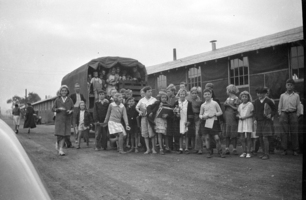 | Back to e-WV
| Back to e-WV
 The West Virginia Encyclopedia
The West Virginia Encyclopedia
 | Back to e-WV
| Back to e-WV
 The West Virginia Encyclopedia
The West Virginia Encyclopedia

Now a residential community, Eleanor began as a government attempt to help victims of the Great Depression. During the 1930s, the U.S. Resettlement Administration offered subsistence homesteads in several communities nationally, including three in West Virginia, to provide houses and land at easy credit. The first such project was Arthurdale in Preston County, which began in 1933. Eleanor in Putnam County soon followed.
The site was a tract of flat land on the north side of the Kanawha River, often referred to as Red House. Potential homesteaders were evaluated on need and ability to work, although many were eliminated because of racial and ethnic discrimination. The men lived in barracks while they worked, building roads and houses and digging water and sewer lines. The houses were built to last, from locally made cinder blocks and chestnut wood.
Serious work began in 1934. The design included a community farm and barn, public gas and water works, workshops, a school, greenhouse, canning plant, market, gas station, restaurant, garage, and pool room. The community had its own newspaper, the Melting Pot, and home economists, a doctor, and public nurses. By 1935, families began moving into their new homes.
The town took its name from Eleanor Roosevelt, who visited several times. The experiment proved to be a success. As the economy improved, Eleanor made the transition from government to private ownership and was subsequently incorporated. Nearly all the original houses are still standing. Eleanor had a population of 1,548 in 2020.
The Eleanor Historic District was add to the National Register of Historic Places in 2023.
Written by Rick Wilson
Wilson, Rick. Happy to Have a Chance: The Founding of Eleanor. Goldenseal, (Spring 1988).